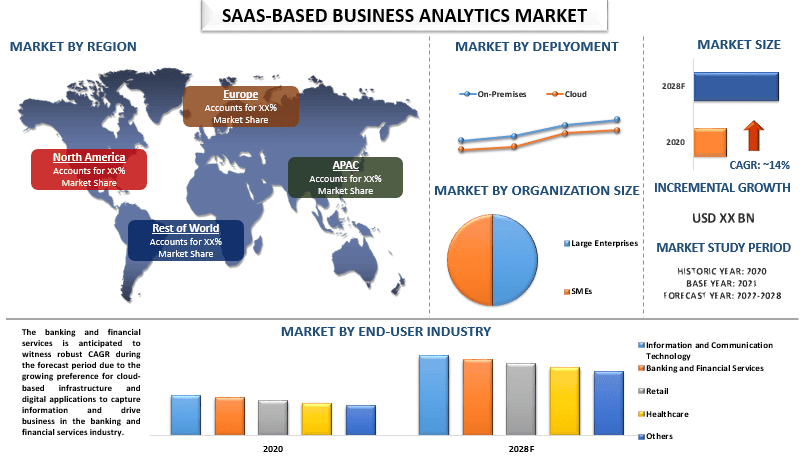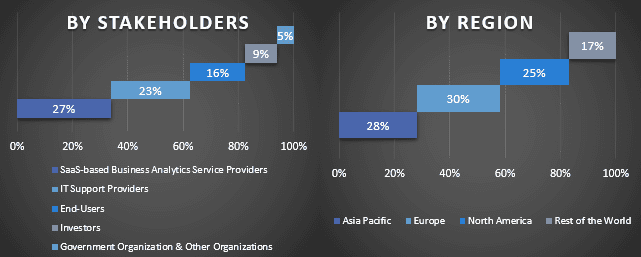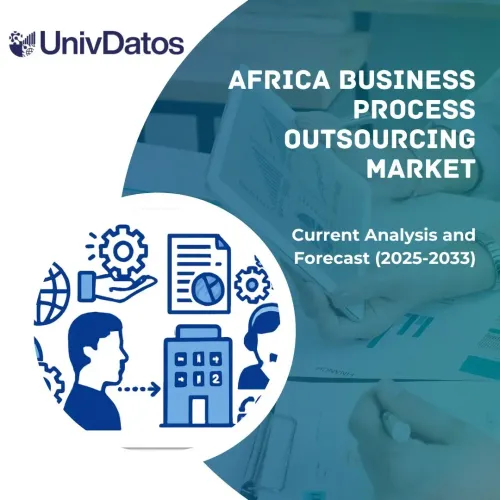- Home
- About Us
- Industry
- Services
- Reading
- Contact Us
SaaS-based Business Analytics Market: Current Analysis and Forecast (2022-2028)
Emphasis on Deployment (On-premises and Cloud); Organization Size (Large Enterprises and SMEs); Industry (Information and Communication Technology, Banking and Financial Services, Retail, Healthcare, and Others); and Region/Country

The global SaaS-based business analytics market is expected to register a CAGR of around 14% over the period of 2022-2028. SaaS-based business analytics software helps enterprises interpret and analyze business data by enabling continuous research and exploration of past business performance and uncovering actionable insights for business strategy. It helps enterprises in discovering patterns and connections between data streams and automate tasks and processes for real-time decision-making. Due to its low cost and ease of use, cloud-based business analytics software is in high demand among small businesses. Further on, factors such as the growing acceptance of cloud computing among various industries, increasing use of business analytics to drive process and cost efficiencies, and increasing applications of artificial intelligence (AI) and big data analytics in businesses are further contributing to the growth of this market. Moreover, increasing investment in AI and AI startups is further contributing to the growth of this market. For instance, according to the 2022 Stanford AI Index report, private venture investment in AI surged to USD 93.5 Bn in 2021, more than doubling from 2020.
GoodData Corporation, Oracle Corporation, International Business Machines Corporation, MicroStrategy Incorporated, OpenText Corporation, QlikTech International AB, SAP SE, SAS Institute Inc., Microsoft Corporation, and TIBCO Software Inc. are some of the key players in the market. Several M&As along with partnerships have been undertaken by these players to facilitate customers with hi-tech and innovative products/technologies.
Insights Presented in the Report
“Amongst organization size, the large enterprises held a prominent share in the market in 2020”
By organization size, the market is bifurcated into large enterprises and SMEs. Among these two, the large enterprises seized a considerable share of the global SaaS-based business analytics market mainly due to the need for enhanced customer experience, improved efficiency, reduced manufacturing cost, better product management, etc. Moreover, business analytics gives businesses an excellent overview and insight into how companies can become more efficient, and these insights enable such businesses to optimize and automate their processes.
“Amongst end-user industry, banking and financial services accounted for a prominent share in the market in 2020”
On the basis of the end-user industry, the SaaS-based business analytics market is segmented into information and communication technology, banking and financial services, retail, healthcare, and others. The banking and financial services are anticipated to witness robust CAGR during the forecast period, due to the growing preference for cloud-based infrastructure and digital applications to capture information and drive business in the banking and financial services industry.
“North America to witness significant growth during the forecast period”
North America held a prominent share of the market in 2020 and is expected to showcase a prominent growth rate during the forecast period. The growth of this market can be attributed to the presence of key market players in the region and the quick adoption of new technologies. In addition, the increasing focus on AI and big data analytics in the major economies in the region is further contributing to the growth of this market. For instance, on May 5th, 2021, the White House Office of Science and Technology Policy released the new “AI.gov” a website dedicated to connecting the American people with information on federal government activities advancing the design, development and responsible use of trustworthy AI. Moreover, according to Stanford University Artificial Intelligence Index, in 2020, there were 4 funding rounds worth $500 million or more; in 2021, there were 15.
Reasons to buy this report:
- The study includes market sizing and forecasting analysis validated by authenticated key industry experts.
- The report presents a quick review of overall industry performance at one glance.
- The report covers an in-depth analysis of prominent industry peers with a primary focus on key business financials, product portfolio, expansion strategies, and recent developments.
- Detailed examination of drivers, restraints, key trends, and opportunities prevailing in the industry.
- The study comprehensively covers the market across different segments.
- Deep dive regional level analysis of the industry.
Customization Options:
Global SaaS-based business analytics market can further be customized as per the requirement or any other market segment. Besides this, UMI understands that you may have your own business needs, hence feel free to connect with us to get a report that completely suits your requirements.
Table of Content
Research Methodology for the SaaS-based Business Analytics Market Analysis (2022-2028)
Analyzing the historical market, estimating the current market, and forecasting the future market of the global SaaS-based business analytics market were the three major steps undertaken to create and analyze the adoption of SaaS-based business analytics in major regions globally. Exhaustive secondary research was conducted to collect the historical market numbers and estimate the current market size. Secondly, to validate these insights, numerous findings and assumptions were taken into consideration. Moreover, exhaustive primary interviews were also conducted, with industry experts across the value chain of the global SaaS-based business analytics market. Post assumption and validation of market numbers through primary interviews, we employed a top-down/bottom-up approach to forecasting the complete market size. Thereafter, market breakdown and data triangulation methods were adopted to estimate and analyze the market size of segments and sub-segments of the industry pertains to. Detailed methodology is explained below:
Analysis of Historical Market Size
Step 1: In-Depth Study of Secondary Sources:
Detail secondary study was conducted to obtain the historical market size of the SaaS-based business analytics market through company internal sources such as annual report & financial statements, performance presentations, press releases, etc., and external sources including journals, news & articles, government publications, competitor publications, sector reports, third-party database, and other credible publications.
Step 2: Market Segmentation:
After obtaining the historical market size of the SaaS-based business analytics market, we conducted a detailed secondary analysis to gather historical market insights and share for different segments & sub-segments for major regions. Major segments included in the report as the deployment, organization size, and industry. Further country-level analyses were conducted to evaluate the overall adoption of testing models in that region.
Step 3: Factor Analysis:
After acquiring the historical market size of different segments and sub-segments, we conducted a detailed factor analysis to estimate the current market size of the SaaS-based business analytics market. Further, we conducted factor analysis using dependent and independent variables such as deployment, organization size, and industry of SaaS-based business analytics. A thorough analysis was conducted for demand and supply-side scenarios considering top partnerships, mergers and acquisitions, business expansion, and product launches in the SaaS-based business analytics market sector across the globe.
Current Market Size Estimate & Forecast
Current Market Sizing: Based on actionable insights from the above 3 steps, we arrived at the current market size, key players in the global SaaS-based business analytics market, and market shares of the segments. All the required percentage shares split, and market breakdowns were determined using the above-mentioned secondary approach and were verified through primary interviews.
Estimation & Forecasting: For market estimation and forecast, weights were assigned to different factors including drivers & trends, restraints, and opportunities available for the stakeholders. After analyzing these factors, relevant forecasting techniques i.e., top-down/bottom-up approach were applied to arrive at the market forecast about 2028 for different segments and sub-segments across the major markets globally. The research methodology adopted to estimate the market size encompasses:
- The industry’s market size, in terms of revenue (USD) and the adoption rate of the SaaS-based business analytics market across the major markets domestically
- All percentage shares, splits, and breakdowns of market segments and sub-segments
- Key players in the global SaaS-based business analytics market in terms of solutions offered. Also, the growth strategies adopted by these players to compete in the fast-growing market
Market Size and Share Validation
Primary Research: In-depth interviews were conducted with the Key Opinion Leaders (KOLs) including Top Level Executives (CXO/VPs, Sales Head, Marketing Head, Operational Head, and Regional Head, Country Head, etc.) across major regions. Primary research findings were then summarized, and statistical analysis was performed to prove the stated hypothesis. Inputs from primary research were consolidated with secondary findings, hence turning information into actionable insights.
Split of Primary Participants in Different Regions

Market Engineering
Data triangulation technique was employed to complete the overall market estimation and to arrive at precise statistical numbers for each segment and sub-segment of the global SaaS-based business analytics market. Data was split into several segments & sub-segments post studying various parameters and trends in the areas of deployment, organization size, and industry in the global SaaS-based business analytics market.
The main objective of the Global SaaS-based Business Analytics Market Study
The current & future market trends of the global SaaS-based business analytics market were pinpointed in the study. Investors can gain strategic insights to base their discretion for investments from the qualitative and quantitative analysis performed in the study. Current and future market trends determined the overall attractiveness of the market at a regional level, providing a platform for the industrial participant to exploit the untapped market to benefit as a first-mover advantage. Other quantitative goals of the studies include:
- Analyze the current and forecast market size of the SaaS-based business analytics market in terms of Value (USD). Also, analyze the current and forecast market size of different segments and sub-segments
- Segments in the study include areas of deployment, organization size, and industry.
- Define and analysis of the regulatory framework for the SaaS-based business analytics market industry.
- Analyze the value chain involved with the presence of various intermediaries, along with analyzing customer and competitor behaviors of the industry.
- Analyze the current and forecast market size of the SaaS-based business analytics market for the major region.
- Major countries of regions studied in the report include Asia Pacific, Europe, North America, and Rest of the World.
- Company profiles of the SaaS-based business analytics market and the growth strategies adopted by the market players to sustain in the fast-growing market
- Deep dive regional level analysis of the industry
Related Reports
Customers who bought this item also bought










